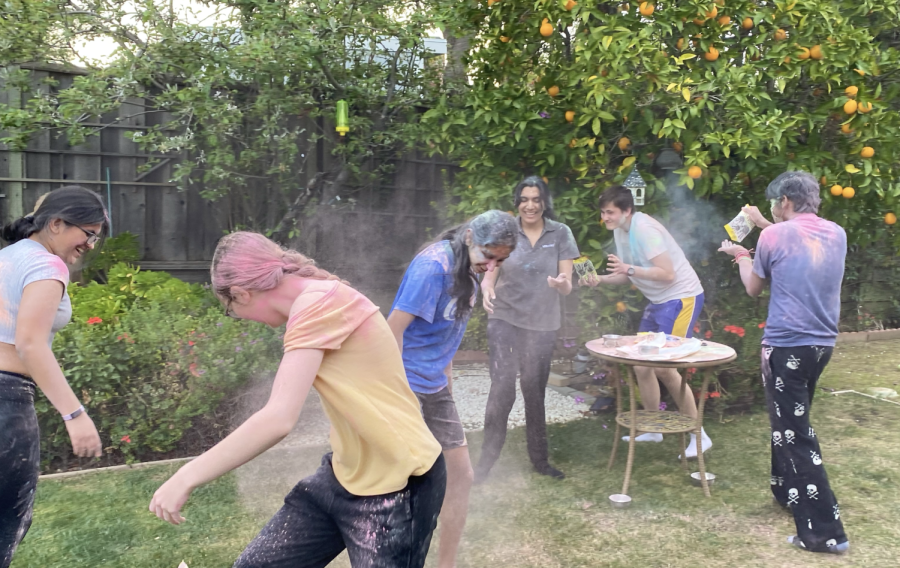Flames of triumph and hues of spring: Upper school students and staff celebrate Holi with family and friends
Provided by Simren Kochhar
Seniors Keya Mann, Camilla Lindh, Simren Kochhar, Saanvi Arora, Tristan Goodwin and Ishaan Parate throw powdered color at each other to celebrate Holi on March 18. Holi, or the Festival of Spring or Colors, is a Hindu festival most commonly celebrated in India, although people also take part in festivities all over the world.
April 20, 2022
Upper school students and staff celebrated the Indian spring festival Holi on March 17 and 18 by taking part in the festival’s traditions with family and friends.
Holi, or the Festival of Spring or Colors, is a Hindu festival most commonly celebrated in India, although people also take part in festivities all over the world. Celebrations occur over two days in March: on “purnima,” the day of the full moon,and the day after.
“Holi, to me, is a fun event where you can meet with your friends and enjoy the vibrant colors and festivities,” Arjun Gurjar (10) said. “I remember when my friends went to a park where they were holding a Holi celebration, and we were given water guns and packets of colored powder. It was really fun.”
The festivities of Holi begin with a bonfire called “Holika Dahan,” meant to represent the triumph of good over evil and the burning of evil spirits. The ritual stems from the story of Vishnu and Hiranyakashipu, in which the sister of the evil king, Holika, attempted but failed to kill Vishnu’s devotee, Prahalad, by burning him in a fire. People often place a sculpture of Holika in the pyre while singing and dancing around the fire.
The morning after Holika Dahan, people take part in the most famous celebration of Holi, playing with colors. Celebrations include throwing water colors of different shades at each other using water guns and balloons, while many people of various backgrounds also throw powdered colors, hence the name “Festival of Colors.” Different colors represent a variety of meanings — green for fresh starts, blue to symbolize the skin color of Hindu deity Krishna, yellow as the natural remedy tumeric and red for love and fertility. In the afternoon, children and adults wash up and visit friends and relatives with snacks and sweets, such as yogurt and cracker snacks, called “Dahi Vada” or “Bhalla,” and “Gujia,” a fried sweet dumpling, to symbolize new beginnings.
Accounts of Holi date back to the 4th century CE during the reign of King Chandragupta II of the Gupta Empire, although historians believe that the holiday existed before the common era, previously serving as a rite for the happiness of married women. Modern-day beliefs in the festival revolve around a variety of stories, including the celebration of the love between Hindu deities Krishna and Radha and the victory of Hindu god Vishnu over an evil and arrogant king named Hiranyakashipu.
“Whenever Holi came, there wasn’t anything related to religion, [so even] if my neighbor is a Muslim they would also come out and play with us although it’s a Hindu celebration,” upper school administration and attendance coordinator Ritu Raj said. “That’s how we grew up, [and] there’s not any restriction that says only Hindus are playing it.”
Holi celebrations took place in Harker prior to the COVID-19 pandemic, via the distribution of handouts on the history of Holi in the preschool. Parents also brought snacks and colors for students to celebrate the holiday with in the lower school.
Celebrations also happened locally in the past through Holi with the Asha for education Stanford chapter, which held Holi celebrations in Wilbur Field, Stanford. After a break due to the pandemic, Asha Stanford will return to the festivities on April 23 and 24 from 10 a.m. to 6 p.m. on Wilbur Field. All proceeds from the event will fund education for children in India.
“We have been celebrating Holi for as long as I can remember,” Raj said. “Even with the pandemic, we are trying to recreate the same experience we had back in India.”


















![“[Building nerf blasters] became this outlet of creativity for me that hasn't been matched by anything else. The process [of] making a build complete to your desire is such a painstakingly difficult process, but I've had to learn from [the skills needed from] soldering to proper painting. There's so many different options for everything, if you think about it, it exists. The best part is [that] if it doesn't exist, you can build it yourself," Ishaan Parate said.](https://harkeraquila.com/wp-content/uploads/2022/08/DSC_8149-900x604.jpg)




![“When I came into high school, I was ready to be a follower. But DECA was a game changer for me. It helped me overcome my fear of public speaking, and it's played such a major role in who I've become today. To be able to successfully lead a chapter of 150 students, an officer team and be one of the upperclassmen I once really admired is something I'm [really] proud of,” Anvitha Tummala ('21) said.](https://harkeraquila.com/wp-content/uploads/2021/07/Screen-Shot-2021-07-25-at-9.50.05-AM-900x594.png)







![“I think getting up in the morning and having a sense of purpose [is exciting]. I think without a certain amount of drive, life is kind of obsolete and mundane, and I think having that every single day is what makes each day unique and kind of makes life exciting,” Neymika Jain (12) said.](https://harkeraquila.com/wp-content/uploads/2017/06/Screen-Shot-2017-06-03-at-4.54.16-PM.png)








![“My slogan is ‘slow feet, don’t eat, and I’m hungry.’ You need to run fast to get where you are–you aren't going to get those championships if you aren't fast,” Angel Cervantes (12) said. “I want to do well in school on my tests and in track and win championships for my team. I live by that, [and] I can do that anywhere: in the classroom or on the field.”](https://harkeraquila.com/wp-content/uploads/2018/06/DSC5146-900x601.jpg)
![“[Volleyball has] taught me how to fall correctly, and another thing it taught is that you don’t have to be the best at something to be good at it. If you just hit the ball in a smart way, then it still scores points and you’re good at it. You could be a background player and still make a much bigger impact on the team than you would think,” Anya Gert (’20) said.](https://harkeraquila.com/wp-content/uploads/2020/06/AnnaGert_JinTuan_HoHPhotoEdited-600x900.jpeg)

![“I'm not nearly there yet, but [my confidence has] definitely been getting better since I was pretty shy and timid coming into Harker my freshman year. I know that there's a lot of people that are really confident in what they do, and I really admire them. Everyone's so driven and that has really pushed me to kind of try to find my own place in high school and be more confident,” Alyssa Huang (’20) said.](https://harkeraquila.com/wp-content/uploads/2020/06/AlyssaHuang_EmilyChen_HoHPhoto-900x749.jpeg)







